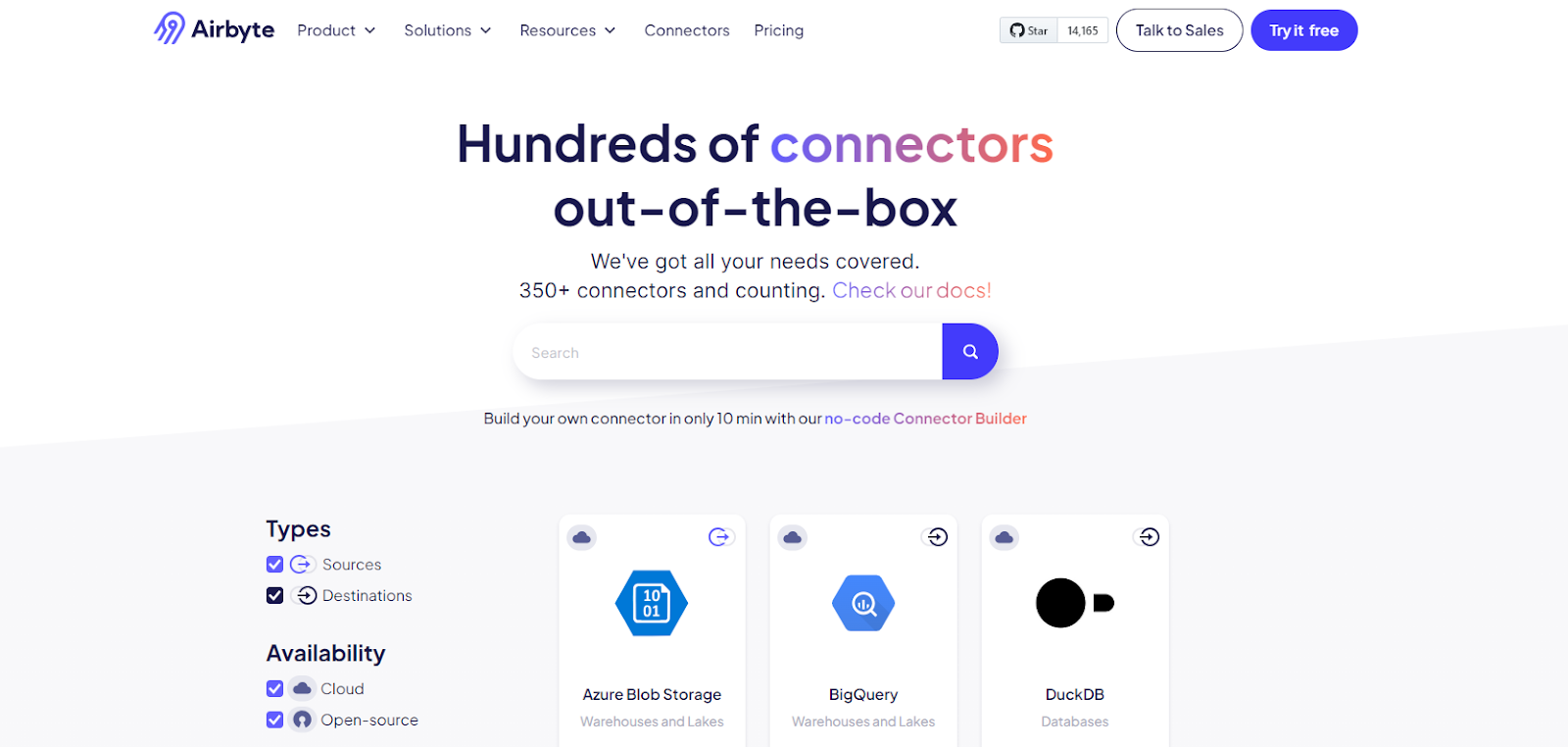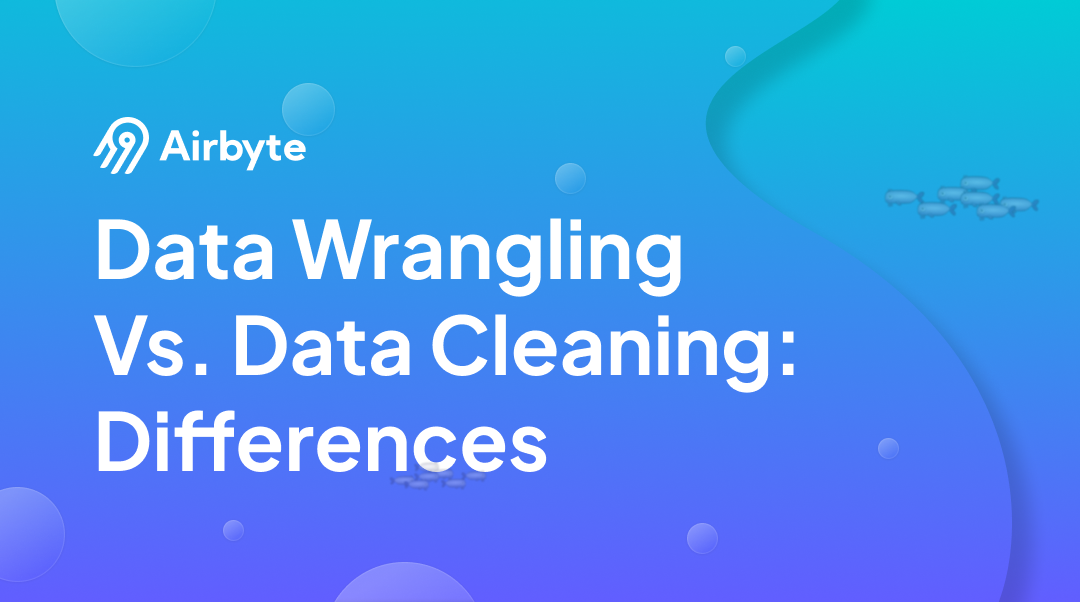Data Wrangling Vs. Data Cleaning: What’s the Difference
Summarize this article with:
✨ AI Generated Summary
Data wrangling transforms and structures raw, unorganized data into an analysis-ready format through six steps: acquisition, structuring, cleaning, enriching, validating, and publishing. Data cleaning, a subset of wrangling, focuses on removing errors, duplicates, missing values, and inconsistencies to improve data accuracy and integrity.
- Data wrangling enhances efficiency, consistency, and quality for better insights.
- Data cleaning eliminates bias and errors, ensuring reliable datasets for analysis.
- Tools like Airbyte simplify data integration by automating and streamlining the wrangling process.
Generating insights from data is crucial for organizations aiming to make informed decisions and scale their operations. Typically, data is collected from multiple sources and is often unorganized. This can introduce bias in the reporting process, eventually leading to decisions that do not significantly impact the business.
To resolve these issues, it would be beneficial to consider data wrangling and data cleaning before using the data for analysis.
This article highlights the differences between data wrangling and data cleaning, details the steps involved in each, and discusses the advantages of implementing each.
What is Data Wrangling?
Data wrangling, also known as data munging, involves transforming and mapping data from one structure to another to prepare it for analysis.
In real-world scenarios, the readily available data is often complex and unstructured. Data wrangling helps simplify this data, making it more accessible and easier to process. This facilitates more effective data analysis.
What Are the Processes Involved in Data Wrangling?
Data wrangling involves six key steps:
Step 1: Data Acquisition
This is the initial phase of data wrangling. It involves identifying the data you will be working with, its sources, and the formats in which it is available.
Step 2: Structuring the Data
In this step, you transform the raw data into a more readable, consistent, and usable format. It involves structuring the data into a tabular format or defining data types for each element.
Step 3: Data Cleaning
This step involves cleaning, transforming, and mapping data from different sources to ensure its reliability and accuracy. Common data-cleaning tasks involve eliminating duplicate values, handling missing values, creating new fields, aggregating data, and other enhancements.
Step 4: Data Enriching
This step involves modification of the existing data to enrich it with additional information. Data enriching includes adding new features or information from external sources related to the data that can help you generate better insights.
Step 5: Data Validating
Data Validation is the quality assurance step that ensures the data adheres to specific standards. This step involves setting up rules and tests to help verify data integrity.
Step 6: Data Publishing
This final step involves moving the data into a data warehouse or another storage solution and making it accessible for further analysis.
What Are the Advantages of Data Wrangling?
Data wrangling offers multiple benefits to enhance data handling and analysis. Some notable benefits include:
- Maintains Consistency: Data wrangling helps maintain data consistency by providing structure and uniformity to the raw data. It rearranges the data in an accessible format that is ready for analysis.
- Enhances Data Quality: It enables you to transform raw, unstructured data containing inconsistencies and errors into a reliable and easy-to-read dataset. This helps increase the accuracy of the insights derived from the data.
- Improves Efficiency: Unstructured data can slow the ability to gain insights. Data wrangling significantly enhances data quality, facilitating faster extraction of valuable information.
- Efficient Time Utilization: Data scientists often spend considerable time processing raw data. Automating the data wrangling process by using specialized tools can save a lot of time, allowing them to focus on better strategies.
- Streamlines Analysis: Algorithms and data analysis tools work best with consistent and clean data. Data wrangling empowers you to prepare the data into an analysis-ready format, saving additional time and reducing complications.
What is Data Cleaning?
Data cleaning is the process of eliminating inaccuracies, inconsistencies, and errors from data. It is a crucial subset of data wrangling focused on error elimination and data integrity.
Data cleaning involves identifying and correcting anomalies, duplicate values, and errors. As the data is often combined from multiple sources, it might contain discrepancies that must be resolved. The goal of data cleaning is to remove these discrepancies while preserving the insights available from the data.
What Are the Processes Involved in Data Cleaning?
Let’s look into the common processes involved in data cleaning.
Step 1: Data Inspection
This initial step involves evaluating the dataset to identify inconsistencies, errors, duplicate values, and outliers. It highlights the specific changes that require attention.
Step 2: Removing Duplicate Values
Data cleaning includes removing duplicate values to prevent skewed data analysis. It ensures that each value is present only once in the dataset, helping maintain data integrity.
Step 3: Handling Missing Data
Missing data can be either removed or imputed with a statistically significant value, such as mean, median, or mode.
Step 4: Filtering Outliers
Data cleaning helps identify and filter outlier values that bias the data. This helps maintain the accuracy of insights.
Step 5: Data Standardization
Data standardization involves converting the dataset into a consistent format by formatting, encoding, or normalizing it. Data normalization converts the data into a specific range of values to ensure that some features are not dominant over others in analysis.
Step 6: Data Verification
The final data cleaning step involves thoroughly checking the data to ensure no inaccuracies are present. Data verification is vital to gain data that is cleansed and ready for analysis.
What Are the Advantages of Data Cleaning?
Here are some of the most prominent advantages of data cleaning:
- Error Elimination: Data cleaning helps eliminate errors and inconsistencies in data. The process involves identifying mistakes present in the dataset and either removing them or replacing them with significant values.
- Reduction in Bias: It can help you remove duplicate values and anomalies that might bias the dataset in a specific direction. Training machine learning algorithms with this clean data enhances the accuracy and insight generation of the models.
- Improved Data Integrity: Data cleaning improves data integrity by removing inconsistencies and inaccuracies. It enhances the integrity of data while also ensuring data reliability and accuracy.
- Cost Reduction: Data cleaning can improve the efficiency of analytical tools, leading to better predictions and reducing the need for reanalyzing data. It reduces the costs associated with repeated analyses and saves time.
Differences Between Data Wrangling Vs. Data Cleaning
The main difference between Data Wrangling and Data Cleaning is that Data Wrangling involves transforming raw data into a usable format, including structuring and enriching it, while Data Cleaning focuses on identifying and correcting errors or inconsistencies in the data.
Choosing between data wrangling vs data cleaning depends on your specific goals. While data wrangling helps you shape your data for analysis, data cleaning ensures data accuracy. Here are the key differences between data wrangling vs data cleaning.
While both data wrangling and data cleaning may seem similar, they have their differences. Understanding these differences is crucial for effectively managing your data workflow.
Simplify Your Data Movement Journey with Airbyte

Data wrangling can consume a significant portion of your data analysis workflow, especially if performed manually. Integrating data from multiple sources into a single destination, a core part of data wrangling, can be complex. To streamline this process, many companies opt for SaaS-based data integration tools like Airbyte.
Airbyte is a data integration and replication platform that simplifies data transfer from multiple sources to a destination. Its user-friendly interface offers 350+ pre-built connectors for various data sources. You can use Airbyte to seamlessly integrate data from many popular sources regardless of the data types and formats involved.
With Airbyte, you can also create custom connectors according to your requirements using the Connector Development Kit.
Here are some of the critical features of Airbyte:
- Airbyte offers a dbt Cloud integration, allowing you to execute complex SQL queries to create an end-to-end data pipeline and perform data transformation.
- Airbyte uses the Change Data Capture (CDC) feature to minimize data redundancy and efficiently utilize computational resources when handling large datasets.
- Airbyte provides the Python library called PyAirbyte, which enables you to use Airbyte’s connector library to extract data within your Python environments.
- To manage your workflows, you can effortlessly integrate Airbyte with some of the most widely used data stacks, including Prefect, Airflow, and Dagster.
- It ensures the reliability and confidentiality of your data by complying with security benchmarks such as GDPR, SOC 2, ISO, and HIPAA.
Conclusion
Data wrangling can be a time-consuming and resource-intensive task, yet it is a crucial step in the data analysis workflows. It empowers you to prepare the data for further analysis, ensuring compatibility with machine learning algorithms that help generate valuable insights.
On the other hand, data cleaning is a subset of data wrangling. It removes error values, inconsistencies, anomalies, and other data discrepancies. These issues can introduce bias and restrict the generation of accurate insights.
This article discusses the differences between data wrangling vs data cleaning. Although the two terms may sound similar, they differ significantly. Both processes can be time-intensive but are essential for ensuring the quality and usability of data.
Tools like Airbyte can help streamline your data pipeline workflow. It enables quick integration of data from multiple sources to a destination, simplifying the data wrangling process without any hassle.
Frequently Asked Questions (FAQs)
Q. What are the steps in data cleaning?
Data cleaning involves six steps—inspection, removing duplicate values, handling missing data, filtering outliers, standardization, and verification.
Q. What are the six steps of data wrangling?
The six key data wrangling steps are data acquisition, structuring, cleaning, enriching, validating, and publishing.
Q. Are data wrangling and data munging the same?
Yes, data wrangling and data munging refer to the same concept that makes data useful for further analysis.

